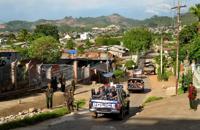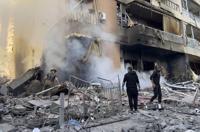BANGKOK (AP) — Ethnic armed groups claimed on Thursday to have captured two strategically important towns in northeastern Myanmar: Lashio, which houses the major regional military headquarters, and Mogok, the center of the country’s lucrative gem-mining industry.
Their fall would be the biggest in a suffered by Myanmar’s military government this year, and raises questions about whether the ruling military council could be forced to give up trying to hold contested territory in order to consolidate a defense of the central heartland.
The ruling military council denied its Lashio headquarters had been taken over, and two town residents contacted by phone said fighting there was continuing. Phone contact with Mogok has been cut off, but video posted on social media appeared to show residents cheering the arrival of ethnic guerrilla soldiers.
Lashio, the biggest city in the northern part of Shan state, and Mogok, the ruby-mining center in the upper Mandalay region, have been the targets of by the MNDAA, the Myanmar ������ϲʹ������� Democratic Alliance Army, and the TNLA, the Ta’ang ������ϲʹ������� Liberation Army, since late June.
The MNDAA is a military force of the Kokang minority, who are ethnic Chinese, and the TNLA represents the Ta’ang, or Palaung, ethnic minority. The groups have been fighting for decades for greater autonomy from Myanmar’s central government, and are loosely allied with the People’s Defense Force, or PDF, the pro-democracy resistance that arose to fight military rule after the army of Aung San Suu Kyi in 2021.
The two armed groups are part of the , which last October launched a surprise offensive that succeeded in seizing large tracts of territory along the northern border with China. The current round of fighting marked an end to a January that nominally stopped that fighting between the alliance and the army for almost six months.
Beijing maintains close relations with both groups, as well as with the military government, and above all seeks stability in Myanmar, which is a strategic ally.
The MNDAA said in a statement published Thursday on its Facebook page that the group had completely captured the military's Northeast Command headquarters in Lashio at 4 a.m. that morning, after 23 days of the fighting.
The MNDAA had captured a regional military headquarters in Laukkaing, a key city on the Chinese border, during the earlier Three Brotherhood Alliance offensive, but the Lashio headquarters is more important.
The MNDAA statement said its claimed capture of Lashio, about 110 kilometers (70 miles) south of the Chinese border, was a “historic victory.”
However, Maj. Gen. Zaw Min Tun, the spokesperson of the ruling military council, said in a message sent to the journalists on Thursday that the claims of the capture of the military command headquarters were untrue.
He said the insurgents had infiltrated some neighborhoods on the outskirts of the city, and the army is fighting to clear them out.
“The loss of Lashio would be a major strategic blow for the regime,” Morgan Michaels, a Singapore-based analyst with the International Institute of Strategic Studies who runs its project, said in an email. “The city is home to the Northeast Command and is the junta’s last major line of defense in northern Shan State. There could be about 5,000 regime defenders in the city, so depending on what happens to them – whether they withdraw, surrender, or get destroyed—that could have an impact on the army’s overall force posture as well.”
The TNLA, in a statement published on the Telegram messaging platform, said it had completely captured Mogok after seizing all the military outposts and government offices there in a month of the fighting. Mogok, which is at the center of Myanmar's lucrative gem mining industry, is about 110 kilometers (70 miles) northeast of Mandalay, the country’s second-largest city.
It said it captured about 30 army soldiers and more than 200 weapons.
Photos and videos circulating widely on social media were said to show the members of TNLA and its allies in the People’s Defense Force being warmly welcomed by by the town’s residents
However, the claims about Mogok's capture could not be verified independently, with access to the internet and mobile phone services in the town area mostly cut off.
“The capture of Mogok would be a significant victory for the TNLA and an embarrassing loss for the junta,” said analyst Michaels. “The Mogok Valley is the largest source of rubies in the world and provides enormous revenue-generating opportunities for the TNLA.”








































